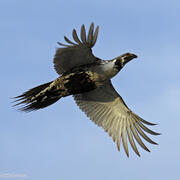Sagebrush-Associated Species
Sagebrush-Associated Species
Filter Total Items: 44
USGS Science Syntheses for Public Lands Management
Scientific information is fundamental to understanding how proposed actions on public lands may impact the environment. Development of new science is occurring at rates that can make it challenging for biologists, resource managers, decision makers, private landowners, and other stakeholders to ensure they are using up-to-date, high-quality science information to inform their decisions. Further...
WebDART: A Cutting-edge Web Tool that Evaluates Land Condition
WebDART is an online ecological assessment tool available to a wide audience that incorporates Landsat satellite remote sensing imagery, topography, geology, soil conditions, and rangeland geospatial and vegetation mapping to compare altered terrain with an unspoiled area that has similar characteristics in the same region. The tool gives resource managers, landowners, companies, and other...
Sagebrush Landscape Collaborative
Encompassing over 175 million acres, America’s “Sagebrush Sea” is the largest terrestrial ecosystem in the lower 48 states. A predominately shrubland system, this landscape ranges over deserts, valleys, mountains, and mesas from the Canadian border to our southwestern deserts. The sagebrush ecosystem – the ancestral homeland of many Tribal Nations – supports critical agricultural and recreation...
Assessing vegetation and avian community response to juniper reduction treatments in Southwest Montana
The Southwest Montana Sagebrush Partnership (SMSP) team, including land managers, landowners, and scientists, is implementing conifer removal projects encompassing over 55,000 acres of private, state, and federal lands throughout the region. To date, little place-based information exists regarding likely vegetation and bird responses to such treatments in Southwestern Montana. To address this...
Modeling chronic wasting disease prevalence through time to investigate mechanisms of spread in deer and elk in Wyoming
Diseases are challenging to manage in wild ungulate populations, particularly when there are many ways the disease can spread. Wildlife management agencies often need to take action to control disease spread, but it is unclear which actions are most effective in constraining disease because the importance of different spread mechanisms is not fully understood. This project will aid state wildlife...
Conservation Efforts Database
The Conservation Efforts Database (CED) is a secure online data repository that collects, stores, and retrieves spatially explicit, spatially obscure, and non-spatial information on species and habitat conservation and management actions. The CED is designed to allow data collection from all interested partners including federal, state, local, non-government organizations, universities, private...
Gunnison Sage-Grouse Recovery Module
The CED Gunnison Sage-grouse Recovery Module was released in 2020 and is designed to capture any effort designed to benefit Gunnison sage-grouse recovery. This includes habitat restoration and any activities that contribute to the recovery of Gunnison sage-grouse, a federally listed threatened species. While similar to the Sagebrush Module, The Gunnison Sage-Grouse Recovery module contains fields...
Sagebrush Module
The CED Sagebrush Module, first released in 2014, captures any conservation effort, enhancement, restoration, plan, or action related to the sagebrush landscape or activities that benefit sagebrush-dependent species. The CED was originally focused only on greater sage-grouse and thus, most of the records currently in our database are related to this species, but, starting in 2019, we expanded our...
Greater Sage-Grouse Population Monitoring Framework: Cheat Sheet
The Greater Sage-grouse Population Monitoring Framework fills a prominent information gap to help inform current assessments of sage-grouse population trends at nested spatial and temporal scales. It is centered on four objectives: (1) create a standardized database of lek counts; (2) develop spatial population structures by clustering leks; (3) estimate spatial trends at different temporal...
Greater Sage-Grouse Population Monitoring Framework Data Inputs Information Sheet
To support management decisions, western state wildlife agencies identified the need for a range-wide database that tracks annual counts of greater sage-grouse ( Centrocercus urophasianus; sage-grouse) at leks (breeding sites), recorded since the early 1950s. Researchers at Colorado State University (CSU) and U.S. Geological Survey (USGS) worked with state wildlife agencies to 1) construct this...
Greater Sage-Grouse Population Monitoring Framework
Greater sage-grouse ( Centrocercus urophasianus) are at the center of state and national land use policies largely because of their unique life-history traits as an ecological indicator for health of sagebrush ecosystems. Researchers within the U.S. Geological Survey (USGS) and Colorado State University (CSU) worked with the Bureau of Land Management (BLM) and state wildlife agencies to develop a...
Greater Sage-Grouse Population Monitoring Framework: Trends Analysis Information Sheet
Land and wildlife managers require accurate estimates of sensitive species’ trends to help guide conservation decisions that maintain biodiversity and promote healthy ecosystems. Accurately assessing greater sage-grouse ( Centrocercus urophasianus; sage-grouse) population trends can be difficult because (1) missing lek counts or incomplete repeat counts, (2) variation in counts of sage-grouse from...













